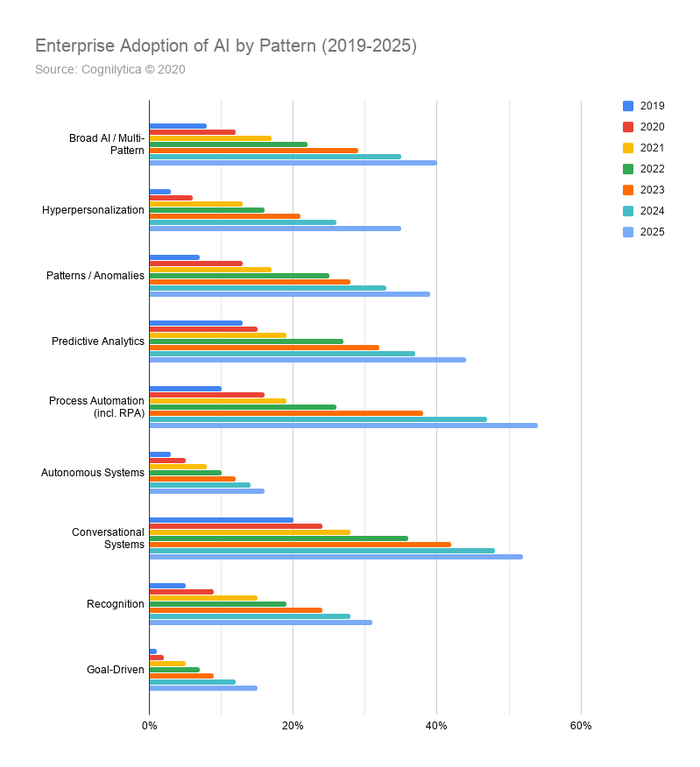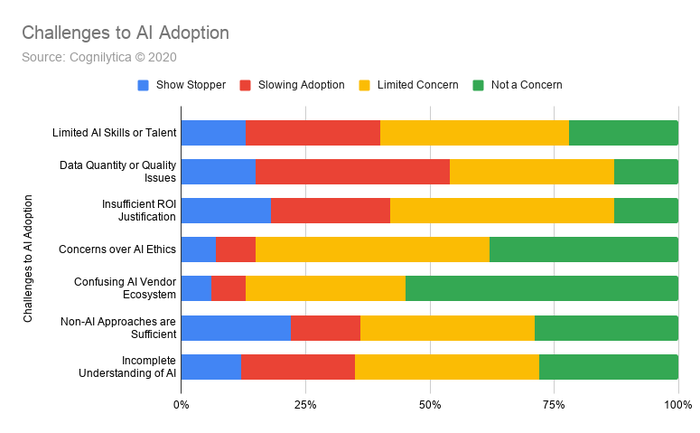Enterprise AI Adoption Gathers Steam – Incrementally, Selectively
A recent report indicates that enterprise AI has gained momentum, but not all real-world AI uses cases are created equal.
February 12, 2020

Artificial intelligence continues to gather steam in the enterprise. But it hasn’t reached majority status among enterprises. Several roadblocks to more widespread AI adoption remain — some linked to talent and data and some to perception– says a recent report from Cognilytica, a research firm.
By 2025, according to “Global AI Adoption Trends & Forecast 2020,” 40% will have deployed AI in some form, compared with 12% in 2020. These numbers indicate that AI in production is still tentative, and enterprises are incrementally making their way toward the technology only as they see immediate return.
“AI is still in the early part of the ‘early majority’ phase with many organizations sitting on the sidelines waiting for do-or-die reasons to implement AI,” the report indicated.
IoT World is North America’s largest IoT event where strategists, technologists and implementers connect, putting IoT, AI, 5G and edge into action across industry verticals. Book your ticket now.]
The four forms of AI on which survey respondents have focused are the following (and see “Enterprise Adoption of AI by Pattern 2019-2025”) :
robotic process automation (54%, compared with 16% in 2020); and
conversational systems, such as chatbots (52% in 2025, compared with 24% in 2020),
predictive analytics (44%, compared with 15% in 2020);
Pattern and anomaly detection (39% in 2025, compared with 13% in 2020).

According to Ron Schmelzer, one of the report’s co-authors, these kinds of AI systems have experienced greater adoption –while still relatively low– because their integration into enterprise operations often involves “just incremental changes from existing non-AI approaches.” Conversely, other forms of AI have lower expected adoption rates in 2020, — hyperpersonalization (6%), autonomous systems (5%) and goal-driven systems (2%) have fewer tools available to shepherd adoption and, sometimes, fewer real-world use cases.
“Hyperpersonalization and autonomous systems are more of a significant change, which explains the slower adoption path,” Schmelzer explained.
Regional Adoption of Artificial Intelligence
Regionally, AI adoption also varies.
Today, 38% of North American respondents have one more multiple projects underway; 28% in Europe, and 23% in Asia, for example. Conversely, 18% plan to deploy AI in the next 12 months in North America versus 22% in Europe and 15% in Asia.
Roadblocks to AI Adoption Involve Talent, ROI
The biggest barrier to AI adoption is insufficient quantity or quality of data (72% of respondents said it was a concern; 15% said it was a show stopper), and limited availability of AI talent and skills (65% said it was a concern; 13% said it was a show stopper; see figure “Challenges to AI Adoption” below).

But additionally, 18% said that there was inadequate ROI justification for using AI to solve operational problems. And 22% said that non-AI approaches are sufficient. That’s because vague terms like AI haven’t garnered the support that specific uses, such as conversational or anomaly detection in cybersecurity have received, Schmelzer said.
There is “confusion on AI capabilities and somewhat overhype of AI by vendors that aren’t really
doing AI,” he said. “When you talk about conversational AI, facial recognition instead of using the general term artificial intelligence,” he said, “organizations are more aware of specific ROI, even if they don’t identify those use cases as AI.
These objections to using AI also suggest that many enterprises need education, examples and possibly training on how AI could work in their environments.Often, this training involves a follow-on issue: democratizing AI algorithms so a broader base of workers can use and derive business insight from them.
For those companies not planning to implement AI within the next two years, the primary “show stopper” was lack of ROI justification for AI projects and an insufficient advantage of AI projects over non-AI approaches.
About the Author
You May Also Like






